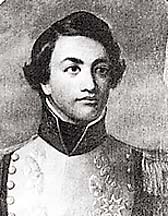

Hawaiian deaths and capitalists'
By Richard Borreca
coming spur revolutionary
1848 land division
Star-BulletinThe great chiefs of Hawaii may not have had actual ownership of Hawaii's land -- the aina -- but they were in charge of it. And no one was going to tell them what to do with the broad fertile valleys and productive fishponds they controlled.
By the time of Kamehameha III in the 1830s, however, the commoners were facing a difficult time as foreign diseases and foreign lifestyle brought across the ocean decimated the population.
As historian Ralph Kuykendall noted, the Hawaiian race in the 19th century was rapidly declining and extinction was openly predicted. Who, then, would occupy the land?
"The connection between this and land question is perfectly obvious," Kuykendall wrote.
"Foreigners having a prospective future interest in the land were anxious to convert it into a real and present one."
At the same time, the chiefs were concerned that without a plan to meet the powerful foreign interests, Hawaii and its people would be obliterated.
Chiefs had land but little cash -- and with commoners moving to the populated port areas, leaving the productive countryside, the chiefs had no source of revenue.
So the great land revolution came.

It was dubbed the Mahele of 1848, a division of the land into four categories: land belonging to the king, land belonging to the alii or chiefs, land that could be purchased by the foreigners who lived in Hawaii, and land worked by the commoners or makaainana."It was without a doubt an event of great moment, one of those watersheds in a people's history which resulted in catastrophic consequences for the race," Lilikala Kame'eleihiwa, director of the University of Hawaii Center for Hawaiian Studies, wrote in her doctoral thesis, "Land and the Promise of Capitalism."
Riley Moffat, head of the Brigham Young University-Laie reference department and co-author of "Surveying the Mahele," explained that painful as the transition was, Hawaii would not have lasted long with its feudal land arrangement.
"It had to be done sooner or later as Hawaii was moving into the modern world," he said. "In one sense, Hawaii was lucky that they were able to do it peacefully."
Hawaiian chiefs, Moffat said, were worried about foreign intervention. Already in the Pacific, the French had forcibly taken Tahiti, and there was worry that Hawaii would follow.
Foreigners living here 151 years ago saw the land division as a way to bring hard work and moral values to a population they did not understand and thought lazy.
"The missionaries for their part persisted in a curious argument which held that only the private ownership of lands would save the Hawaiian race from extinction," Kame'eleihiwa wrote.
She said the foreigners argued that if the commoners owned their own land, they would give up the "licentious, indolent, improvident and ignorant" ways. This would then stop the Hawaiian race from dying.
"Of course, what was needed was medicine, not capitalism," she added.
Dramatic changes were pushed on Hawaiians as surveyors carved up property and tax collectors tallied property taxes. When Hawaiians fell into debt, their land was auctioned off.
The commoners fared badly in the division, with only 8,000 of them receiving about 2.5 acres each, or less than 1 percent of the total lands. And the land revolution quickly led to other, dramatic upheavals.
"Within 30 years," Kame'eleihiwa wrote, "Westerners controlled most of the land received by the 10 highest chiefs, and in 1893, overthrew the Hawaiian government."
The Honolulu Star-Bulletin is counting down to year 2000 with this special series. Each month through December, we'll chronicle important eras in Hawaii's history, featuring a timeline of that particular period. Next month's installment: July 12. About this Series
Millennium Series Archive
Project Editor: Lucy Young-Oda
Chief Photographer: Dean Sensui